-

新人教版高中英语选修2Unit 4 Using langauge-Listening教学设计
The theme of the listening section is " talking about scenery and culture along a journey."The part is designed to further lead the students to understand Canadian natural geography and social environment, and integrated into the cultural contrast by mentioning the long train journey from Beijing to Moscow routes. On this basis, the part activates students related travel experience, lets the student serial dialogue, guides the student to explore further the pleasure and meaning of the long journey, and Chinese and foreign cultural comparison.The part also provides a framework for the continuation of the dialogue, which is designed to provide a framework for students to successfully complete their oral expressions, and to incorporate an important trading strategy to end the dialogue naturally.1. Help students to understand and master some common English idioms in the context, and experience the expression effect of English idioms.2. Guide the students to understand the identity of different people in the listening context, and finish the dialogue according to their own experience.3. Instruct the students to use appropriate language to express surprise and curiosity about space and place in the dialogue, and master the oral strategy of ending the dialogue naturally.1. Instruct students to grasp the key information and important details of the dialogue.2. Instruct students to conduct a similar talk on the relevant topic.

新人教版高中英语选修2Unit 4 Learning about Language教学设计
This section guides students to pay attention to the typical context of vocabulary use, helps students accumulate vocabulary around the key vocabulary of this unit, and uses the learned words and word chunks in different contexts to deeply understand their meaning and usage, so as to achieve the purpose of review and consolidation.The teaching design activities aim to guide students to pay attention to the typical context in which the target vocabulary is used, as well as the common vocabulary used in collocation, so that students can complete the sentence with correct words. In terms of vocabulary learning strategies, this unit focuses on cultivating students' ability to pay attention to collocation of words and to use word blocks to express meaning.For vocabulary learning, it is not enough just to know the meaning of a single word, but the most important thing is to master the common collocations of words, namely word blocks.Teachers should timely guide students to summarize common vocabulary collocation, such as verb and noun collocation, verb and preposition collocation, preposition and noun collocation, and so on.1. Guide students to understand and consolidate the meaning and usage of the vocabulary in the context, 2. Guide the students to use the unit topic vocabulary in a richer context3. Let the students sort out and accumulate the accumulated vocabulary, establishes the semantic connection between the vocabulary,4. Enable students to understand and master the vocabulary more effectivelyGuiding the Ss to use unit topic words and the sentence patterns in a richer context.

新人教版高中英语选修2Unit 5 Learning about Language教学设计
The purpose of this section of vocabulary exercises is to consolidate the key words in the first part of the reading text, let the students write the words according to the English definition, and focus on the detection of the meaning and spelling of the new words. The teaching design includes use English definition to explain words, which is conducive to improving students' interest in vocabulary learning, cultivating their sense of English language and thinking in English, and making students willing to use this method to better grasp the meaning of words, expand their vocabulary, and improve their ability of vocabulary application. Besides, the design offers more context including sentences and short passage for students to practice words flexibly.1. Guide students to understand and consolidate the meaning and usage of the vocabulary in the context, 2. Guide the students to use the unit topic vocabulary in a richer context3. Let the students sort out and accumulate the accumulated vocabulary, establishes the semantic connection between the vocabulary,4. Enable students to understand and master the vocabulary more effectivelyGuiding the Ss to use unit topic words and the sentence patterns in a richer context.Step1: Read the passage about chemical burns and fill in the blanks with the correct forms of the words in the box.

新人教版高中英语选修2Unit 3 Learning about Language教学设计
1. We'll need ten months at least to have the restaurant decorated.2.Some traditional Chinese dishes from before the Ming Dynasty are still popular today.3.My grandpa's breakfast mainly includes whole grain biscuits and a glass of milk.4.People in this area would eat nearly a kilo of cheese per week.5. We enjoyed a special dinner in a fancy restaurant where the waiters all wore attractive suits.6. He prefers this brand of coffee which, as he said, has an unusually good flavor.Key:1. at a minimum 2. prior to3. consist of4. consume5. elegant6. exceptionalStep 5:Familiarize yourself with some food idioms by matching the meaning on the right with the colored words on the left.1.Public concern for the health of farm animals has mushroomed in the UK2.Anderson may be young but he's certainly rolling to doing dough!3.George is a popular lecturer. He often peppers his speech with jokes.4.As the person to bring home the bacon, he needs to find a stable job.5 He is often regarded as a ham actor for his over emphasized facial expressions. The media reported that these companies had treated pollution as a hot potato. 6.The media reported that these companies had treated pollution as a hot potato.7.Don't worry about the test tomorrow. It's going to be a piece of cake!8. It's best to fold the swimming ring when it is as flat as a pancake.A. completely flatB. something that is very easy to do C.an issue that is hard to deal withD.to include large numbers of somethingE.to earn on e's living to support a familyF. wealthyG.to rapidly increase in numberH. an actor who performs badly, especially by over emphasizing emotions

新人教版高中英语选修2Unit 3 Using langauge-Listening教学设计
1. How is Hunan cuisine somewhat different from Sichuan cuisine?The heat in Sichuan cuisine comes from chilies and Sichuan peppercorns. Human cuisine is often hotter and the heat comes from just chilies.2.What are the reasons why Hunan people like spicy food?Because they are a bold people. But many Chinese people think that hot food helps them overcome the effects of rainy or wet weather.3.Why do so many people love steamed fish head covered with chilies?People love it because the meat is quite tender and there are very few small bones.4.Why does Tingting recommend bridge tofu instead of dry pot duck with golden buns?Because bridge tofu has a lighter taste.5 .Why is red braised pork the most famous dish?Because Chairman Mao was from Hunan, and this was his favorite food.Step 5: Instruct students to make a short presentation to the class about your choice. Use the example and useful phrases below to help them.? In groups of three, discuss what types of restaurant you would like to take a foreign visitor to, and why. Then take turns role-playing taking your foreign guest to the restaurant you have chosen. One of you should act as the foreign guest, one as the Chinese host, and one as the waiter or waitress. You may start like this:? EXAMPLE? A: I really love spicy food, so what dish would you recommend?? B: I suggest Mapo tofu.? A: Really ? what's that?

新人教版高中英语选修2Unit 5 Using langauge-Listening教学设计
The theme of this section is to learn how to make emergency calls. Students should learn how to make emergency calls not only in China, but also in foreign countries in English, so that they can be prepared for future situations outside the home.The emergency telephone number is a vital hotline, which should be the most clear, rapid and effective communication with the acute operator.This section helps students to understand the emergency calls in some countries and the precautions for making emergency calls. Through the study of this section, students can accumulate common expressions and sentence patterns in this context. 1.Help students accumulate emergency telephone numbers in different countries and learn more about first aid2.Guide the students to understand the contents and instructions of the telephone, grasp the characteristics of the emergency telephone and the requirements of the emergency telephone.3.Guide students to understand the first aid instructions of the operators.4.Enable Ss to make simulated emergency calls with their partners in the language they have learned1. Instruct students to grasp the key information and important details of the dialogue.2. Instruct students to conduct a similar talk on the relevant topic.Step1:Look and discuss:Match the pictures below to the medical emergencies, and then discuss the questions in groups.
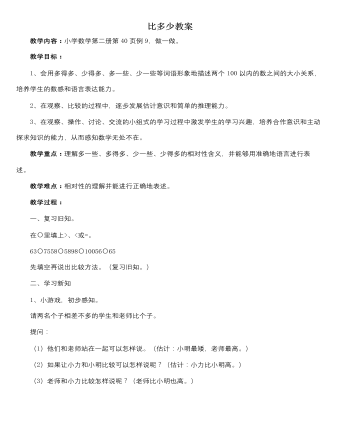
人教版新课标小学数学一年级下册比多少教案
教学目标:1、会用多得多、少得多、多一些、少一些等词语形象地描述两个100以内的数之间的大小关系,培养学生的数感和语言表达能力。2、在观察、比较的过程中,逐步发展估计意识和简单的推理能力。3、在观察、操作、讨论、交流的小组式的学习过程中激发学生的学习兴趣,培养合作意识和主动探求知识的能力,从而感知数学无处不在。教学重点:理解多一些、多得多、少一些、少得多的相对性含义,并能够用准确地语言进行表述。教学难点:相对性的理解并能进行正确地表述。教学过程:一、复习旧知。在O里填上>、<或=。63O7558O5898O10056O65先填空再说出比较方法。(复习旧知。)
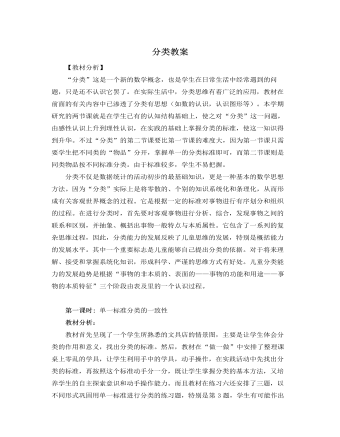
人教版新课标小学数学一年级上册分类教案
教学目标:1.能选择不同的标准对同一类物品进行不同的分类,掌握分类的方法。2.初步感知不同标准分类的意义,体验分类结果在不同标准下的多样性。3.培养学生思维的灵活性和发散性,养成良好的学习、生活习惯。4.培养学生的操作能力、观察能力、判断能力、语言表达能力和合作交流的意识。5.让学生体会到生活中处处有数学,学会用学到的知识解决生活中的实际问题。教学重、难点:重点:选择不同标准分类难点:思维的发散性 关键:在直观中拓展思维的时空教学准备:铅笔、实物卡片、学具袋(各种形状、颜色各异的物品)教学过程:一、观察分析 多重分类1.师出示如书本P39页的铅笔。(1)观察这些铅笔有什么不同?并把它们分分类。(2)四人一小组交流、讨论可以怎么分类?是按什么分的?比比哪一组的分法最多。
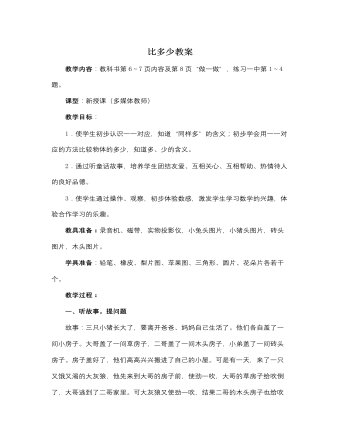
人教版新课标小学数学一年级上册比多少教案
4.操作。(“做一做”第2题) 全班同学动手操作,1名同学到投影仪上操作。 (1)第1行摆5个△,在△下面摆○,△要比○多1个。第2行摆几个○? (2)第1行摆4朵红花,摆的黄花比红花少1朵,第2行摆几朵黄花? 二、运用新知 教科书练习一第1~4题。 1.第1题:左图是猴子多,右图是骨头多。(避免学生产生思维定势) 2.第2题:学生观察,看到公鸡和鸭子虽然摆的一样长,但疏密不同,进而判断摆的密的鸭子的只数多些,而公鸡只数少些。 3.第3题:学生在观察到第一排蛋糕同样多的基础上,只需比较两盒中的第二排。第二排多的就多些,反之,就少些。 4.第4题:此题是在同一排中比较多少,当第5次循环出现珠子时,只出现了一个黄色珠子,所以黄珠子多而红珠子少。 三、总结 教师:今天我们学习了“比一比”,知道在比较时,一定要一个对着一个比,就会得到正确的结果。
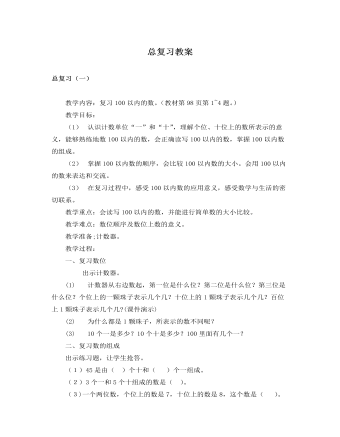
人教版新课标小学数学一年级下册总复习教案
教学内容:复习100以内的数。(教材第98页第1~4题。)教学目标:(1) 认识计数单位“一”和“十”,理解个位、十位上的数所表示的意义,能够熟练地数100以内的数,会正确读写100以内的数,掌握100以内数的组成。(2) 掌握100以内数的顺序,会比较100以内数的大小。会用100以内的数来表达和交流。(3) 在复习过程中,感受100以内数的应用意义,感受数学与生活的密切联系。教学重点:会读写100以内的数,并能进行简单数的大小比较。教学难点:数位顺序及数位上数的意义。教学准备;计数器。教学过程:一、复习数位出示计数器。(1) 计数器从右边数起,第一位是什么位?第二位是什么位?第三位是什么位?个位上的一颗珠子表示几个几?十位上的1颗珠子表示几个几?百位上1颗珠子表示几个几?(课件演示)(2) 为什么都是1颗珠子,所表示的数不同呢?(3) 10个一是多少?10个十是多少?100里面有几个一?
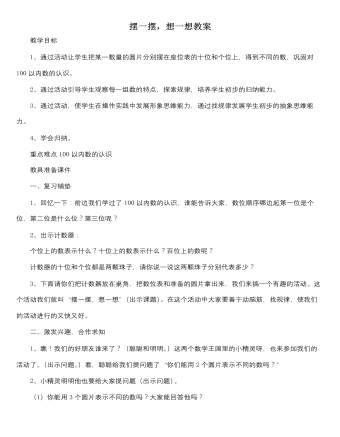
人教版新课标小学数学一年级下册摆一摆,想一想教案
每组4名小朋友3名在数位板上摆圆片,1名小朋友对摆出的结果进行综合、记录。3、全班一起用2个圆片摆出不同的数,引导学生讨论一下问题:(1)为什么两个圆片摆在个位上得到的数十2,而摆在十位上得到的数十20?(2)记录摆出的数是需要注意什么?(3)怎样才能知道摆出的数不遗漏?4、从刚才小朋友们用圆片摆数的过程,你发现有没有规律?下面我们不摆圆片,能不能在脑子里想摆圆片的方法,直接写出6个圆片,7个圆片,8个圆片,9个圆片都能表示哪些数?好,四个人合作,看哪一组填写的又快又好!学生分组活动:分别用3、4、5、6、7、8、9个圆片摆出不同的数。5、从以上我们所摆的圆片个数和写出来的数来看,同学们观察到有什么规律了吗?谁能说一说。
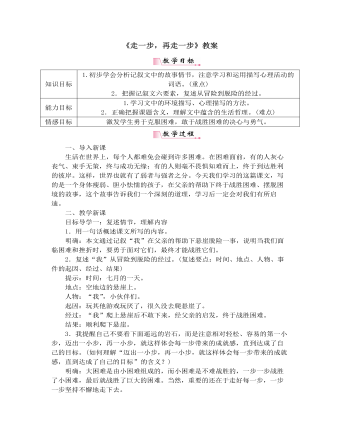
部编版语文七年级上册《走一步再走一步》教案
【教学提示】题目的设计意图是要培养同学们患难与共的爱心,克服困难的勇气和决心。目标导学二:分析环境和心理描写1.文章开头为什么突出“酷热”?明确:开头一自然段主要写孩子们为什么想到去爬悬崖。写天气的酷热,通过环境描写,突出了人物的心理,即酷热使人烦躁,小伙伴就厌倦了正在玩的游戏,从而想到很久没有爬悬崖。2.“时间在慢慢地过去。影子在慢慢拉长,太阳已经没在西边低矮的树梢下,夜幕开始降临。”“暮色中,第一颗星星出现在天空中,悬崖下面的地面开始变得模糊。”这两句话是什么描写?请简要分析其作用。明确:这是典型的环境描写,很好地烘托了“我”的恐惧心理。3.当“我”被弃于悬崖时,“我”的心理状态是怎样的?请从文中找出描写“我”处于险境中的心理状态的词句。明确:“我”的心理状态是恐惧。词语:阵阵晕眩、天旋地转、神情恍惚。句子:“我听见有人在哭泣、呻吟;我想知道那是谁,最后才意识到那就是我。”“我趴在岩石上,神情恍惚,害怕和疲劳已经让我麻木。”
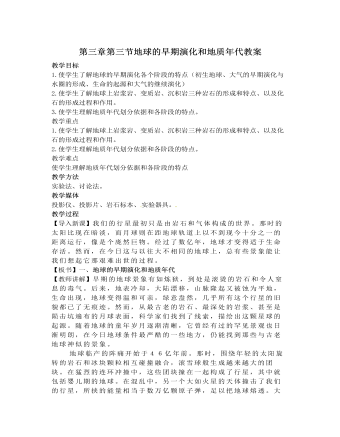
人教版高中地理选修1第三章第一节地球的早期演化和地质年代教案
地质年代可分为相对年代和绝 对年龄(或同位素年龄)两种。相对地质年代是指岩石和地层之间的相对新老关系和它们的时代顺序。地质学家和古生物学家根据地层自然形成的先后顺序,将地层分为5代12纪。即早期的太古代和元古代(元古代 在中国含有1个震旦纪),以后的古生代、中生代和新生代。古生代分为寒武纪、奥陶纪、志留纪、泥盆纪、石炭纪和二叠纪,共7个纪;中生代分为三叠纪、侏罗纪和白垩纪,共3个纪;新生代只有第三纪、第四纪两个纪。在各个不同时期的地层里,大都保存有古代动、植物的标准化石。各类动、植物化石出现的早晚是有一定顺序的,越是低等的,出现得越早,越是高等的,出现得越晚。绝对年龄是根据测出岩石中某种放射性元素及其蜕变产物的含量而计算出岩石的生成后距今的实际年 数。越是老的岩石,地层距今的年数越长。

新人教版高中英语选修2Unit 1 Science and Scientists-Discovering useful structures教学设计
The grammatical structure of this unit is predicative clause. Like object clause and subject clause, predicative clause is one of Nominal Clauses. The leading words of predicative clauses are that, what, how, what, where, as if, because, etc.The design of teaching activities aims to guide students to perceive the structural features of predicative clauses and think about their ideographic functions. Beyond that, students should be guided to use this grammar in the context apporpriately and flexibly.1. Enable the Ss to master the usage of the predicative clauses in this unit.2. Enable the Ss to use the predicative patterns flexibly.3. Train the Ss to apply some skills by doing the relevant exercises.1.Guide students to perceive the structural features of predicative clauses and think about their ideographic functions.2.Strengthen students' ability of using predicative clauses in context, but also cultivate their ability of text analysis and logical reasoning competence.Step1: Underline all the examples in the reading passage, where noun clauses are used as the predicative. Then state their meaning and functions.1) One theory was that bad air caused the disease.2) Another theory was that cholera was caused by an infection from germs in food or water.3) The truth was that the water from the Broad Street had been infected by waste.Sum up the rules of grammar:1. 以上黑体部分在句中作表语。2. 句1、2、3中的that在从句中不作成分,只起连接作用。 Step2: Review the basic components of predicative clauses1.Definition

新人教版高中英语选修2Unit 1 Science and Scientists-Learning about Language教学设计
Step 7: complete the discourse according to the grammar rules.Cholera used to be one of the most 1.__________ (fear) diseases in the world. In the early 19th century, _2_________ an outbreak of cholera hit Europe, millions of people died. But neither its cause, 3__________ its cure was understood. A British doctor, John Snow, wanted to solve the problem and he knew that cholera would not be controlled _4_________ its cause was found. In general, there were two contradictory theories 5 __________ explained how cholera spread. The first suggested that bad air caused the disease. The second was that cholera was caused by an _6_________(infect) from germs in food or water. John Snow thought that the second theory was correct but he needed proof. So when another outbreak of cholera hit London in 1854, he began to investigate. Later, with all the evidence he _7_________ (gather), John Snow was able to announce that the pump water carried cholera germs. Therefore, he had the handle of the pump _8_________ (remove) so that it couldn't be used. Through his intervention,the disease was stopped in its tracks. What is more, John Snow found that some companies sold water from the River Thames that __9__________________ (pollute) by raw waste. The people who drank this water were much more likely _10_________ (get) cholera than those who drank pure or boiled water. Through John Snow's efforts, the _11_________ (threaten) of cholera around the world saw a substantial increase. Keys: 1.feared 2.when 3. nor 4.unless 5.that/which 6.infection 7.had gathered 8.removed 9.was polluted 10.to get 11. threat

新人教版高中英语选修2Unit 1 Science and Scientists-Using langauge教学设计
This happens because the dish soap molecules have a strong negative charge, and the milk molecules have a strong positive charge. Like magnets, these molecules are attracted to each other, and so they appear to move around on the plate, taking the food coloring with them, making it look like the colors are quickly moving to escape from the soap.Listening text:? Judy: Oh, I'm so sorry that you were ill and couldn't come with us on our field trip. How are you feeling now? Better?? Bill: Much better, thanks. But how was it?? Judy: Wonderful! I especially liked an area of the museum called Light Games.it was really cool. They had a hall of mirrors where I could see myself reflected thousands of times!? Bill: A hall of mirrors can be a lot of fun. What else did they have?? Judy: Well, they had an experiment where we looked at a blue screen for a while, and then suddenly we could see tiny bright lights moving around on it. You'll never guess what those bright lights were!? Bill: Come on, tell me!? Judy: They were our own blood cells. For some reason, our eyes play tricks on us when we look at a blue screen, and we can see our own blood cells moving around like little lights! But there was another thing I liked better. I stood in front of a white light, and it cast different shadows of me in every color of the rainbow!? Bill: Oh, I wish I had been there. Tell me more!? Judy: Well, they had another area for sound. They had a giant piano keyboard that you could use your feet to play. But then, instead of playing the sounds of a piano, it played the voices of classical singers! Then they had a giant dish, and when you spoke into it, it reflected the sound back and made it louder. You could use it to speak in a whisper to someone 17 meters away.? Bill: It all sounds so cool. I wish I could have gone with you? Judy: I know, but we can go together this weekend. I'd love to go there again!? Bill: That sounds like a great idea!

人教版新课标PEP小学英语三年级上册Hello!教案4篇
(3)通过游戏Simon says 来练习以show, open, close, put, carry 所引导的祈使句。教师发指令学生做动作。但只有听到老师带有Simon says的指令时,才能做出相应的动作,否则就是失败。失败的同学退出游戏。(4)听Let's chant的录音,学生边听边做,逐渐过渡成边听边说边做,最后独立说做,并进行比赛。4. 课堂评价(Assessment)做活动手册本单元第5部分练习。学生根据录音,圈出所听到的文具。具体方法和步骤参考如下:(1)学生看图,用英语说出图中每样文具物品。(2)教师讲解题目的意思并指导做的方法。(3)学生听录音做练习。(4)再放录音,在教师的指导下让学生一句一句地跟读并互相核对答案,并说出所圈的文具,再通过给花朵涂色进行自我评价。5. 扩展性活动(Extensive activities)选词游戏。将学生分为六组,每组各派一个选手,教师说单词,选手快步跑到讲台前,找到所说单词,并举起大声读出,正确为胜。
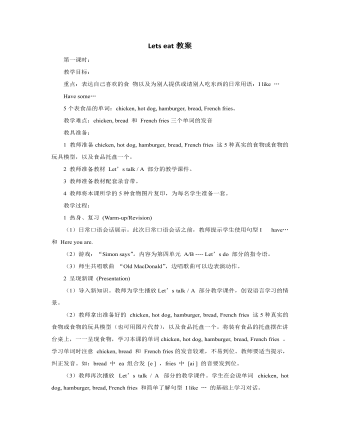
人教版新课标PEP小学英语三年级上册Lets eat教案
教师将本课A、B部分所学单词的图片卡贴在黑板上,找两个学生各手持一把新苍蝇拍,教师读出一个单词,学生就要马上找出来并拍立一下。第一个拍的学生获胜。(4)教师准备一个小场景:将所有学过的食品及饮料或模型放在一个铺着台布的桌上,请学生根据A、B部分的Let’s talk进行自由会话。2.新课展示(Presentation)(1)本课时Let’ s learn中的单词认读教学,可继续采用A部分第二课时的教学方法,利用课件,让学生利用已掌握的拼读规则,认读和学习新单词。(2)让学生听Let’s learn的录音,一边听,一边指着书上相应的图,力求做到“眼到,手到,口到,心到”。(3)用一组连贯的动作教Let’s do中的动词Pour,smell,taste,drink。首先,教师左手端着一个茶壶,右手拿一茶杯,对全班说:Look!I’m pouring the tea. Pour the tea.(边倒茶,边说两遍)。
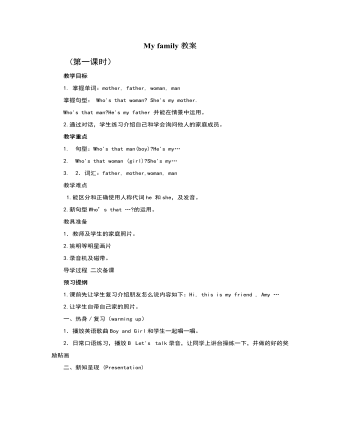
人教版新课标PEP小学英语三年级下册My family教案
1.能够听、说、读、写字母H h, Ii,并能听说认读以这些字母为首字母的单词:hamburger, hot dog ,ice-cream, ice.2.听懂Let’s do 中的字母和短语,并做出相应的动作。如:A B C, look and see.3.听懂Story time 的内容。教学重点 掌握字母H h, I i单词:hamburger, hot dog ,ice-cream, ice。教学难点 1.能够听懂一些指令性短语,并做出相应的动作。2. Story time 的内容教具准备 1.本课时相关的单词卡和图片2. 教材相配套的教学录音带导学过程 二次备课预习提纲1. 课前了解一些食物英语的名称。2. 课前先让学生复习三年级上册FoodPart A Let’s Learn 部分的单词:cake ,bread, chicken…一.热身/复习(warming up)1. 游戏:找朋友将学过的七个字母按大小写分开,一部分学生拿大写字母卡,一部分拿小写字母卡。让拿大写字母卡的学生分别起立读出手中的字母,那对应小写字母卡的学生跟到他前方举起手中的字母,说:I’m… 两人握手2.让学生听三年级上册Part A Let’s Learn部分的录音,了解相关的食物的名称。.
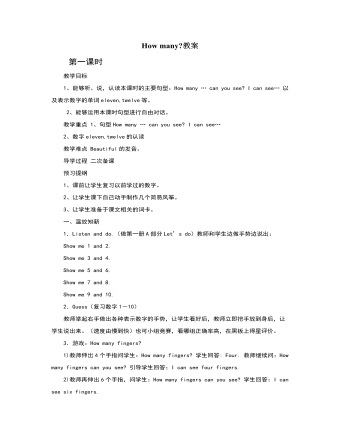
人教版新课标PEP小学英语三年级下册How many教案
一.温故知新1.教师播放“One, two, three, four, five”歌曲的录音带,让学生跟随录音一起唱。2.复习数字1-151)报数:教师让学生从1-15按顺序用英文报数,如果前一个学生报到15了,那么下一个学生就要从1再开始。2)游戏:叫号。教师把写有one —fifteen的单词卡发给学生,教师随意说数字,谁拿着相应的单词卡,谁就站起来并大声读出该单词。3.操练句型How many … can you see? I can see…和How many… do you have? I have…(使用15以内的数字)二.新课呈现 1.教师将1-15的数字卡贴在黑板上,用其中的两张组成一个算式,在两张数字卡的中间写上“+”号,其和为15以内,让学生去计算,如Ten and five is fifteen.2.让学生两人一组,一个学生摆算式,另一个学生用英文说出结果。3.教师出示算式卡,如Nine and seven,让学生快速说出两数之和,并请最先说出答案的学生将算式用数字形式写在黑板上,在单词卡中找到相应的单词贴在和的位置上。

